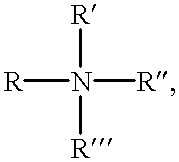Decontamination solution and method
a technology of decontamination solution and solution, applied in the field of compositions, can solve the problems of corrosive corrosiveness, flammability and toxicity of hypochlorite formulations, and certain undesirable properties
- Summary
- Abstract
- Description
- Claims
- Application Information
AI Technical Summary
Problems solved by technology
Method used
Image
Examples
example 1
Decontamination Formulations
A. OAC / Oxidizer Decontaminant
A currently preferred decontaminant composition of the invention contains the following components:
Component Weight Percent Benzyltrimethylammonium chloride 16 Benzyltriethylammonium chloride 4 Hydrogen Peroxide 20 Isobutanolamine 30 Water 30 Total: 100
The decontaminant was prepared as follows. Because of their hygroscopic natures, benzylmethylammonium chloride (28.1 g) and benzyltriethylammonium chloride (6.1 g) were oven dried before use. These compounds were then added to a heated (about 45.degree. C.) mixture of water (3 g) and isobutanolamine (56.1 g). The final mixture was stirred until the solid components have dissolved.
The composition is adjusted to a pH of 9.+-.0.15 with concentrated hydrochloric acid, and mixed 4:1 w / w with 35% hydrogen peroxide. The final product was a clear golden color.
This formulation was used in the neutralization studies in Example 2 below. Two formulations which contained no oxidizer were pre...
example 2
Neutralization of VX
A QAC / oxidizer decontaminant of the invention was prepared as described in Example 1A above and used at a dilution of 20:1 w / w decontaminant:VX. For comparative purposes, a decontaminant containing a QAC mixture, but no oxidizer (prepared as described in Example 1C above was used at a dilution of 10:1 w / w decontaminant:VX.
The neutralization reactions were conducted under ambient conditions. 0.1 mL of VX (CAS Registry No. 50782-69-9) in a 13.times.100 mm culture tube was immediately Vortex mixed upon addition of 1.0 or 2.0 mL decontaminant. A 0.025 mL aliquot of the mixture was immediately withdrawn, and then added to and mixed with 4.97 mL 0.2M sodium dihydrogen phosphate to quench the reaction. Serial dilutions, using deionized water, were made to bring the concentration of the quenched reaction mixture into the analytical range of the acetylcholinesterase inhibition method (0.0002 micrograms). Additional 0.025 mL aliquots of the original mixture were withdrawn ...
example 3
Neutralization of Chemical Warfare Agents
The following assays were used to assay the ability of the decontaminants described herein to neutralize HD (sulfur mustard) and GD. The decontaminant:agent w / w ratios are 50:1 for HD and 20:1 for GD.
A. HD Neutralization Assay
The neutralization reactions were conducted under ambient conditions as follows. 150 mg of HD (sulfur mustard, CAS Registry No. 505-60-2) in a 13.times.100 mm culture tube was immediately Vortex mixed upon addition of 1.0 mL decontaminant. A 0.025 mL aliquot of the mixture was immediately withdrawn, and then added to and mixed with 1.0 mL n-butanol to quench the reaction. Serial dilutions, using n-butanol, were made to bring the concentration of the quenched reaction mixture into the analytical range of the DB-3 colorimetric analytical method (0.5-20 micrograms HD). Additional 0.025 mL aliquots of the original mixture were withdrawn after specified time periods, and treated and analyzed in the manner just described. The ...
PUM
| Property | Measurement | Unit |
|---|---|---|
| Fraction | aaaaa | aaaaa |
| Fraction | aaaaa | aaaaa |
| Fraction | aaaaa | aaaaa |
Abstract
Description
Claims
Application Information
 Login to View More
Login to View More - R&D
- Intellectual Property
- Life Sciences
- Materials
- Tech Scout
- Unparalleled Data Quality
- Higher Quality Content
- 60% Fewer Hallucinations
Browse by: Latest US Patents, China's latest patents, Technical Efficacy Thesaurus, Application Domain, Technology Topic, Popular Technical Reports.
© 2025 PatSnap. All rights reserved.Legal|Privacy policy|Modern Slavery Act Transparency Statement|Sitemap|About US| Contact US: help@patsnap.com

